What Kind Of Palnts Are In An English Garden
There are different types of plants all around us, and most of us recognize many kinds of plants that flower, grow in our gardens, or that we can eat. There is a vast range in the types of plants that grow in the world. Plants such as algae, moss, and ferns are examples of flowerless plants that thrive in damp and wet conditions. Other kinds of plants such as flowering plants and trees grow in all sorts of conditions and are essential for living.
All kinds of plants belong to the kingdom Plantae. They are divided into two groups depending on whether they are seed-bearing plants or plants without seeds. Plants are also classified by their genera, families, and species. This type of plant classification allows for easy identification of plants and makes them easier to study.
Plants classifications also depends on their vascular system. Non-vascular plants such as algae are primitive plants or in a lower class of plants and have simple tissue systems to transport water internally. Vascular plants such as shrubs, trees, herbs, and flowering plants have complex vascular tissue to transport fluid and nutrients internally.
In this article, you will learn about the many different kinds of plants in the world. You will also see examples of shrubs, flowering plants, ferns, and many other types of common plants.
The Main Kinds of Plants
All types of plants are classified by two main groups: plants without seeds and plants with seeds.
Plants without seeds are algae, mosses, ferns, and liverworts. These unique plant types produce spores that are distributed by the wind. For example, if you look on the underneath of fern leaves, you will notice sporangia which are tiny structures containing spores.
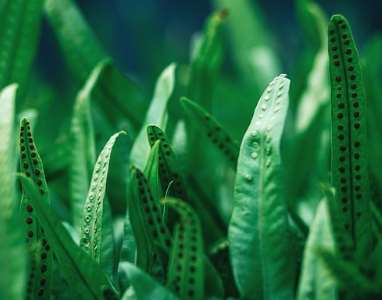
Sporangia in fern plant
Plants with seeds are all kinds of flowering plants, cycads (palm-like plants with cones), conifers (such as spruce, firs, pines, junipers and cedars), and ginko.
Flowering plants produce seeds that are protected within their fruit. These fruits can be soft fruits such as apples, oranges, or berries, or they can be hard like all types of nuts.
Plants with cones, mostly evergreen trees, are another kind of vascular plants with seeds.
Different Kinds of Plants Without Seeds (Pteridophytes, Bryophytes)
Let's look at the 4 main groups of plants that reproduce without seeds:
Algae
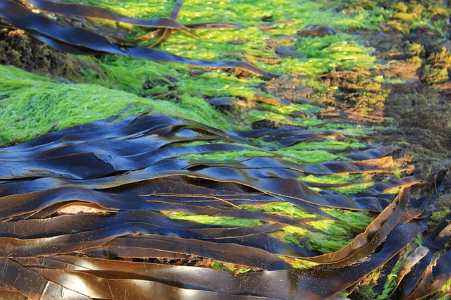
Kelp is a type of large brown algae and it's also an edible seedless plant
Algae consist of a large diverse group of plants that generally grow in water. All types of algae are divided into green algae, brown algae, and red algae. Being such diverse species of organisms, the different groups of algae are not closely related. There are an estimated 72,500 species of algae in the world.
Algae can be tiny microscopic organisms called phytoplankton that is a food source of many marine animals. Or, some types of algae are commonly called seaweed and are found in waters around coastlines.
There is also some confusion whether species of algae are truly types of plants. Like many plants, algae use a process of photosynthesis to make food. Interestingly, some types of algae seem to have the ability to "eat" other organisms similar to animals. However, most people view algae as types of plants. (1, 2)
Brown algae
Brown algae are a common type of algae that generally grow in the sea and are usually good to eat. In fact, some species of brown algae are the largest plants in the world with some growing up to 165 ft. (50 m) tall. One type of edible brown algae is sea kelp that contains high amounts of iodine.
Green algae
Green algae generally grow in freshwater, although they also grow in saltwater. Individual alga (singular of algae) of some species are tiny microscopic organisms. If they are in abundance, they can turn ponds or seawater green. Similar to brown algae, some green algae grow as seaweed.
Red algae
Red algae (Rhodophyta) consist of the largest group (phyla) of all algae species and the majority grow in marine environments. As with all kinds of algae, red algae are plants that don't produce seeds. Red algae are also an important food source and are the type that is used for nori. (3)
Liverworts

Liverworts include many species of plants such as Lunularia cruciata (in the picture)
Liverworts are a type of nonvascular flowerless plant that don't bear seed and are in the division Marchantiophyta. These small leafy plants may be as tiny as 2 mm or grow to 20 mm wide. Liverwort plants tend to flourish in damp places.
Tiny species of liverworts can be difficult to distinguish from mosses. One way to identify liverwort plants is that they are generally smaller and have tiny hair-like structures (rhizoids) they use to absorb water.
Scientists say that liverworts developed after algae and that, although a lower plant form, they are more advanced than algae plants.
Mosses
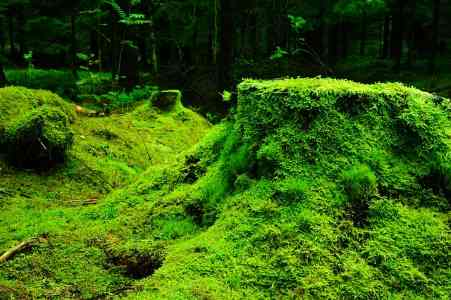
Moss is a type of small flowerless plant that prefers damp or shady places
All moss species belong to the division Bryophyta and there are about 12,000 species of moss. Mosses are often seen growing in damp places similar to liverworts. You can often see pictures of moss growing on rocks, trees, soil, and concrete. The fact that moss doesn't need soil to grow means that this unique plant can grow almost anywhere.
Although mosses were classified with hornworts and liverworts in the Marchantiophyta group, they are now in a classification of their own. There are 8 classes of mosses with the peat-moss Sphagnum being the most commercially important. Sphagnum moss is an unusual plant that is commonly used as mulch, for home decoration, or in the florist trade.
Ferns

Ferns are a type of plant that thrive in damp shady areas
Ferns belong to the group of plants without seeds and are flowerless plants in the class Polypodiopsida. Unlike mosses and algae, ferns are a kind of vascular plant that distributes spores to reproduce. There are an estimated 10,560 species of ferns and some are among the oldest plants on the planet.
Ferns are identified by their green leafy foliage consisting of fronds and pinnae. Outdoors, ferns grow in forests and love damp shady areas. Some of the tallest ferns in the world can grow up to 82 ft. (25 m) tall.
Ferns are also examples of common indoor bedroom houseplants that thrive well in room temperature. Their bushy green foliage and long, trailing leaves can add beautiful greenery to a room. Some common species of ferns to grow indoors include Boston ferns, staghorn ferns, and the bird's nest fern. Many types of perennial ferns are also popular plants for gardens as they grow in areas where other plants can't. Ferns are good examples of ground cover plants, especially in shady areas.
Kinds of Plants with Seeds (Gymnosperms, Angiosperms)
Plants with seeds are one of the largest groups of land plants in the world. Seeds from these plants are either encased in a cone or in fruits that protect the seeds.
Angiosperms are seed-bearing plants that flower and gymnosperms are generally cone-producing trees. All species of plants with seeds are vascular plants and are important for our ecosystem.
Cycads

Cycads are seed plants with pinnate leaves and cone-like reproductive structure (strobilus)
Cycads are an exotic group of plants that grow in tropical and subtropical parts of the world. Similar in appearance to palm trees, cycads have woody trunks that sprout large evergreen leaves. Unlike other types of trees, cycads don't have branches but their leaves grow directly from the trunks.
Seeds from cycad plants are enclosed in cone-like structures. This flowerless tree reproduces by beetles that pollinate the seeds. Scientists say that this ancient exotic-looking plant has changed little since Jurassic times.
Different species of cycads come in various sizes. The smallest type of cycad may have a trunk that is only a few centimeters tall. In fact, this interesting plant looks like it just has long fern-like leaves growing up from the ground. Because of this feature, it is easy to mistake cycads for ferns. Larger cycads can grow large leaves that look as if they are exploding from the top of the trunk. The larger cycad species can grow to a height of between 32 and 50 ft. (10 – 15 m) tall.
If you live in a warm climate, cycads can be very ornamental plants for your garden.
Conifers
Conifers is the common name for woody, shrub-like plants and trees in the division Pinophyta. This group of perennial evergreen trees includes pines, junipers, cedars, and spruces. These important types of trees grow in most climates in the world and are very common in the Northern Hemisphere. They are also the most important group of gymnosperms.
Like cycads, conifers are identified by their seed-producing cones. Some species of conifers have cones that disintegrate to disperse seeds, and others rely on birds for seed dispersal. In fact, their name comes from the Latin meaning "one that bears cones." Although the term Pinophyta is the common scientific name, the division Coniferae can also be used.
Conifers are also identified by their unique type of green, bluish-gray, or silvery foliage. Some types of conifers can be large majestic trees with drooping leaves covered in soft pine needles. Other conifer species can be small, shrub-like evergreen plants that grow well in ornamental gardens. Some examples of small conifers for your garden are dwarf spruce trees, low-growing cypress trees, or small pine evergreen bushes.
One of the survival features of trees such as fir trees, cedars, junipers, yew trees, and pine trees is that they are very cold hardy. Some species of these conifer trees can survive temperatures of -13°F (-25 °C) and lower.
Flowering Plants
Species of flowering plants are some of the most diverse, beautiful, and fascinating of all plants that grow. Plants with seeds that flower can include anything from a tall oak tree to a delicate orchid or beautiful rose.
According to some estimates, there are over 300,000 species of flowering plants that are divided into 13,000 genera, 416 families, and 64 orders. The common characteristic of all plants classed as angiosperms is that they bear seeds in flowers which are the plants' reproductive organs.
Flowering plants are also vascular plants because they have a complex system to transport fluid to all parts of the pant. Types of flowering plants can include flowering vines, trees that blossom, ornamental grasses, and orchids. Also, common flowering plants such as asters, begonias, chrysanthemums, roses, tulips, and herbs are all examples of angiosperms.
Flowering plants can also be classified as annuals or perennials depending on if they survive winter or not. Also, some types of flowers only bloom in springtime or other start flowering in spring and continue producing blossoms until fall.
If you are thinking about landscaping your garden, then it's important to choose the right kind of plant for sun exposure and soil quality. For example, some plant species thrive well in full sun and prove excellent ground cover. Other creeping plants can survive well in partial to full shade.
Flowering annual plants
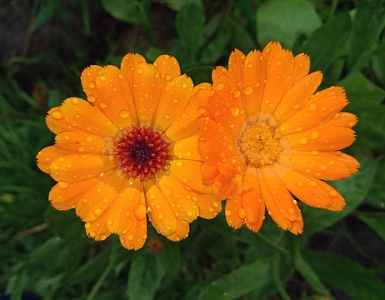
Marigold is very common and popular flowering plant around the world
Annuals are plants that die off in the winter and only leave a dormant seed. Some beautiful types of annuals that flower include pansies, marigolds, snapdragons, petunias, winter violas, and poppies.
Flowering perennial plants
Perennials are kinds of plants that produce flowers every year and don't have to be replanted.
Examples of cool plants that flower year after year include roses, lilac shrubs, stunning hibiscus plants, flowering trees, succulents, and dahlias. Also, flowers that grow from bulbs such as daffodils, tulips, and crocuses are often the first kind of flowers to grow every spring.
Some flowering plants are tender perennials and grow as annuals in cold climate.
Exotic-looking orchids
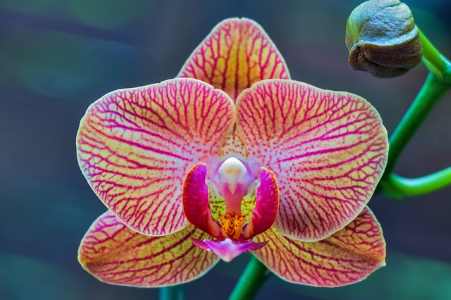
The Phalaenopsis orchids are examples of exotic-looking plants. They are also some of the most popular and easy to care for orchids
Some of the most stunning types of plants to grow indoors are orchids. There are many species of orchids that come in all different colors. Some of the easiest orchids to care for are the Phalaenopsis orchids with large colorful petals and unusual markings.
Types of ivy and flowering vines
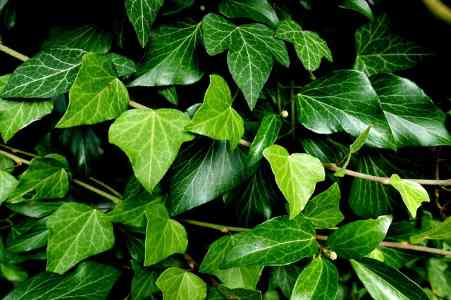
Ivies are fast-growing plants that grow just as well outdoors as they do indoors
Another type of land plant that has seeds and is classified as an angiosperm plant is ivy. Ivy (genus Hedera) is a trailing type of green leafy plant that climbs walls, trellises, and can look good in a hanging basket. Being a member of the 'flowering plant' groups, ivy species also produce blossoms every year.
Ornamental grasses
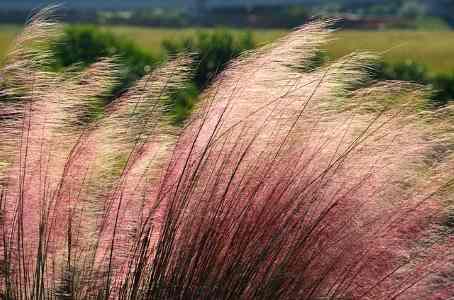
Pink Muhli (Muhlenbergia capillaris) is a perennial ornamental grass
There are many examples of fine ornamental grasses that can provide height, privacy, and beauty for any garden. These ornamental perennial plants have seeds that allow them to reproduce. One of the beauties of ornamental grasses is that they are very versatile and low maintenance. Some clumping grasses grow to just a few centimeters and others can grow to many meters.
Gingko
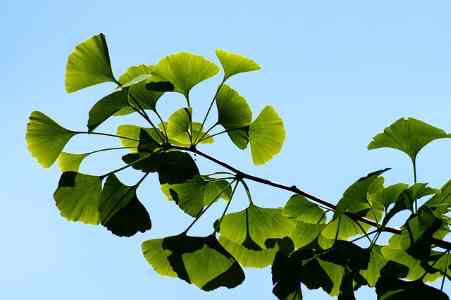
Ginkgo Biloba tree is native to China and has many uses in traditional medicine
Gingko is a type of seed-bearing tree plant, and Gingko Biloba is the only species in the division Ginkgophyta. All the other gingko species are extinct and just one kind of gingko plant survives today. Botanists say that gingko is a unique plant because it isn't related to any other plant that is still alive today.
Also called the maidenhead tree, gingko is unique among the groups of seed-bearing plants. Gingko has unique fan-shaped leaves that can measure between 2" and 4" (5 – 10 cm). Another unique feature of this plant is that the fruit doesn't contain seeds but these are in fruit-like structures called false fruits. Gingko is also one of the oldest types of trees in the world.
Most people have heard of Gingko Biloba as a traditional herbal remedy for a number of ailments. Various kinds of natural treatments are made from the large nut-like seeds.
Related: The Most Amazing Types of Trees in the World (With Pictures)
Dioecious Plants Vs. Monoecious Plants
"Dioecious" and "monoecious" are horticultural terms that relate to plant reproduction. Dioecious describes a plant group that includes distinct male and female plants. This means that the male and female flowers are on different plants. Monoecious describes a single plant that have both male and female flowers.
Related articles:
- 17 Great Ground Cover Plants for Full Sun
- 10 Best Air Filtering House Plants, According to NASA
- Types of Ficus Trees for Outdoors and Indoors
Read Next
What Kind Of Palnts Are In An English Garden
Source: https://leafyplace.com/types-of-plants/
Posted by: whiteeatilten.blogspot.com

0 Response to "What Kind Of Palnts Are In An English Garden"
Post a Comment